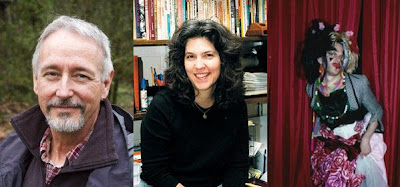Review: Second Person Queer
 Second Person Queer: Who you are (so far)
Second Person Queer: Who you are (so far)Edited by Richard Labonte and Lawrence Schimel
Published by Arsenal Pulp Press
Reviewed by Eric Karl Anderson
Telling a story in the second person necessarily focuses the narrative voice as if the author were speaking to a particular person. Following on from the successful award-winning anthology First Person Queer, this collection gathers forty writers from wildly different perspectives writing essays directly to “you.” Many of the authors have chosen a specific type of individual who they are addressing ranging from macho bears, women throwing play parties, young bisexuals, Asian men in a predominantly white gay community or people who have recently come out. This direct approach makes the concerns which these multifarious voices are speaking of feel immediately relevant, even when you know that the “you” the author is addressing isn’t you specifically. These essays/letters/stories express a wide range of sometimes conflicting opinions. But each of the accounts in this lively, fascinating and provocative anthology speak strongly about how our ever-evolving identities are never stable. As the subtitle states, this anthology speaks about “who you are (so far).”

Other entries present arguments about how “we” as queer people stand in relation to heterosexual society. Jay Starre defiantly states, “You are gay, for God’s sake, and don’t need to fit your love life into some pre-conceived cultural idea of what is right and what is wrong.” Lloyd Meeker elaborates in his essay how “you happen to love men because you are wired so differently than heterosexuals” and that as such we have a special spiritual mission. In some entries like Meeker’s, as with so many cultural discussions about being gay, these arguments are only really including male North American homosexuals. It’s fair enough to discuss only one part of the queer community as many of the entries do considering that each part has its own specific issues. However, in cases like this where political arguments are being made they might be more usefully opened out to discuss other sections of the population. Rest assured, the editors have been careful to include in the anthology a wide-ranging and balanced collection of voices from many different races, age-ranges, locations and genders.
Essays like Jane Van Ingen’s practical ‘How to Archive Our History’ and Victor J. Banis’ meaningful ‘How to Write and Live to Tell about It’ give a much more straightforward call to action, entreating us to document and preserve our experience for current and future generations of queer people to use as touchstones.
 A few of the essays moved me so powerfully with the intensity of their voices that I felt struck to the core and it’s made me read them over and over:
A few of the essays moved me so powerfully with the intensity of their voices that I felt struck to the core and it’s made me read them over and over:
Mattilda Bernstein Sycamore writes a heartfelt letter and tribute to David Wojnarowicz and how his book mattered when Sycamore was literally trying to survive and “learning and living and giving the potential of embracing outsider status in order to create safety, love, community, desire, home on my own terms.” This is a testimony which recalls the sobering fact that so many in our queer community aren’t privileged enough to make it to the stage where they can deliberate all these issues about how to live queer lives.
Achy Obejas lists fifty ways to continue after a break-up. Each point suggests a multitude of stories which give you a sense of the many failed queer relationships which have occurred over the years. Funny, sad and true, this list encompasses a range of ways to end things and begin them again.
And Blair Mastbaum, immediately in the opening pages, questions whether being out necessarily means we should be proud in his startling essay ‘You Know You Know.’ When it’s become the queer orthodoxy that “gay is good” Mastbaum controversially questions whether this is so and, if we are not good individuals, are we merely celebrating a “genetic condition?”
Almost all of the essays contained in Second Person Queer are very short, many only two or three pages long. This makes it a fast-paced read, leaving the reader with an almost dizzying sense of the sheer diversity of what being queer is and how many different points of view there are about how we should live with the fact of our queerness. But this is the point. Like the editors state in their introduction, “SPQ collects a plurality of voices about a range of queer-interest topics, not always on the same page, but always with the same intention: to help you define (or, perhaps, decide) who you are.” This collection certainly achieved its goal in helping me to define and redefine myself. Perhaps Sean Michael Law puts it best in his letter ‘To My Thirteen-Year-Old Daughter Who Just Told Me She’s Bi,’ “being queer isn’t about being just one thing. It’s about understanding the harmony of all things, the necessity of difference and the careful ways that human lives integrate with one another.” Importantly, this is when all the profiling and queer labels break down and you understand finally that you are and always have been an individual.
Eric Karl Anderson is author of the novel Enough and has published work in various publications such as The Ontario Review, Harrington Gay Men’s Fiction Quarterly, Blithe House Quarterly and the anthologies From Boys to Men and Between Men 2.



0 Comments:
Post a Comment
<< Home